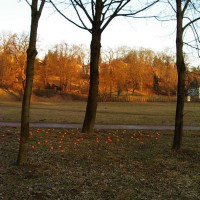Orchard
Materials:
Oranges, stickers, postcards and video.
Concept:
‘Orchard’ is a public art intervention designed to raise questions about consumption and sustainable agricultural, social and economic systems.
Immersed within the landscape, this visually attractive installation subtly adopts the vocabulary of its surroundings in which to speak. An obviously foreign thing within the spring landscape of the park, that simultaneously appears to have grown there quite naturally. The fruit seems to have dropped from the overhanging branches, but on closer inspection it is evident that this is not an orange tree and not even a fruit tree. The artist is playing with time and place.
It is a simple gesture rich in meaning. The installation of the oranges increased daily over the period of a week and reached maximum fruitation when an estimated 52kg of oranges were on site. In Weimar the intervention was located in the historic Ilm Park on the lawn near Goethe’s Garden House.
Weimar is surrounded by small orchards, which used to be communally cultivated during the German Democratic Republic, many of which are now left untended. Fruit drops to the ground and rots. People would rather buy their groceries from the supermarkets passing by the orchards to get there. The sculptural installation ‘Orchard’ placed supermarket oranges, hybrid varieties, into the landscape. Reminding the public of the existing orchards on the periphery of the town. Each orange had a small brand sticker mimicking the ones used in industry. The installation raises questions and stimulates dialogue in the local community by its presence in the park.
The Ilm Park is maintained by a large staff of gardeners – could this public space be used as a source of food for the public?
Of course the climate in Germany is too cold for oranges to grow, but one kilometre away in the grounds of the Belvedere Palace is the ‘Orangerie’ a green house used for storing orange trees in winter, but the oranges eaten in the homes of Weimar residents come mainly from Spain, transported over great distances to arrive fresh in the supermarkets. The sustainability of transporting produce globally as opposed to using locally produced resources is also questioned through this action.
The reaction of the public was mixed, varied and intriguing. Passers by would; stop and eat an orange; carry one off; steal them – checking over their shoulder to see if anyone was watching; gaze up at the tree branches in wonder; have long and intense discussions under the tree; laugh; one couple practiced juggling with the oranges for over twenty minutes and then ate them; scrutinise the label on the orange for clues as to where they came from or what this was about; look intently without touching; adolescents had food fights with orange bombs; people had picnics nearby to keep an eye on what may be happening; young children would collect as many as their little arms could carry and then arrive back some minutes later, to return them on the orders of their parents; one couple had a passionate kiss under the imaginary orange tree others walked by ignoring the site – nose in the air trying not to look.
A series of postcards was dispersed throughout the local cafes and public buildings and three newspaper articles over the week of the action alerted the public to the anomaly in the park.
Some months later a similar action took place in London’s Hyde Park and then on the Spanish island of Mallorca. The responses by the public revealed social and cultural differences in the way communities encountered this alien implantation and the differing cultural perceptions associated with the object itself.
Exhibitions:
Ilm Park Weimar 17th – 24th March 2003 on the lawn in front of Goethe’s Garden House, Weimar, Germany.
Kensington Gardens, on the lawn near Serpentine Gallery, London England. October 2003.
‘Rundgang’, MFPA Building, Bauhaus Univesity Weimar, Germany 2003.
Publications:
HOHMANN, K. (2004) No non-places. IN HOHMANN, K., WEBER, L., REICHMANN, J. & BAUM, H. (Eds.) Public Art and new Artistic Strategies. Weimar, Bauhaus University Weimar, University Publishers. P. 27.
(2003) Drei öffentliche Ideen. Allgemeiner Anzeiger. 9th Apr. ed. Weimar, Germany. P. 3.
(2003) Kommunikative Strategien belebt. TLZ Thüringische Landeszeitung. 4th Apr. ed. Weimar, Germany. P. 5.
(2003) Orange – Berg vor Goethes Gartenhaus. Thüringer Allgemeine. 21st Mar, ed. Weimar, Germany. P. 5.
(2003) Weimarer vernaschen Kunst-Stücke. Thüringer Allgemeine/ Weimarer Allgemeine. 25 Mar, ed. Weimar, Germany. P. 1.
Multi media:
Hohmann, (2004)
http://www.uni-weimar.de/rundgang/zr2003/php/praesentation.php?Projekt_ID=47.
Accessed 16th July 2009.




